|
|
Geohistory
five
centuries of geological research in the Apuan Alps
|
|


 |
The morphological rarity of the Apuan Alps has always
been an attraction for naturalists-travellers, or at least, it has been so
since the 16th century, when a scientific investigation on the mountain
range was carried out to understand its nature and find natural products
useful for economy.
In the modern age famous geologists used to match
excursions with the pleasure of naturalistic knowledge. Famous is
the excursion by Andrea Cesalpino (1525-1603), who focused on a firestone
"stone by ovens",
described as “invincible to fire”, found in Cardoso di Stazzema.
|
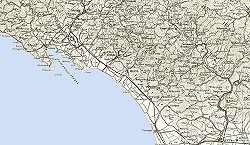
|
|
|
In the 17th
century the bohemian Daniel Meisner (1585-1625) and the dutch Jan Jansson (1588-1664) visited the area and drew the
valley of Seravezza, pinpointing the sites for marble
excavation and silver extraction.
The Apuan Alps, visible from western Florence, were particularly fascinating
for its citizens, who grew up surrounded by Renaissance culture and,
therefore, naturally inclined to discover nature from an aesthetic and
scientific point of view.
|
|
|
%20et%20alii,%20Thesaurus%20philo-politicus…,%20Francoforte%201629.jpg)
Daniel Meisner
(1629): Apuan Alps as natural space of the aesthetic and scientific
discovery of the nature
|
|
|
The visits were already numerous in the 18th century. In those
years, several naturalists showed their
growing interest in the Apuan Alps which had become a privileged research
field for hydrogeological studies and geo-mineral research in Italy.
Here,
Antonio Vallisnieri senior (1661-1730) developed and tested the new
theory on the underground water cycle (1704-1715), thanks to the close
relation between water springs and karst cavities.
Meanwhile, explorations
of mines and studies on mineralization took off, with the active
participation, among others, of Giovanni Arduino (1714-1795) and Lazzaro
Spallanzani (1729-1799).
As a result, the first geological descriptions of
the Apuan Alps was produced, based on Arduino’s chronostratigraphic approach
and pointing out the ancient core of the mountain range consisting of schist
“primitive rocks” covered by “secondary rocks”. moreover, the description of the naturalistic voyage of Giovanni Targioni Tozzetti
(1712-1783) in 1743 is rich in content as he described not only Apuan rocks
and minerals, but also physical landforms and morphogenetic agents.
Antonio
Vallisneri
(1714):
on the origin of
springs, based on an exploration in the Apuan Alps and Apennines
click on image to
start movie
(created by Marco Yais) |
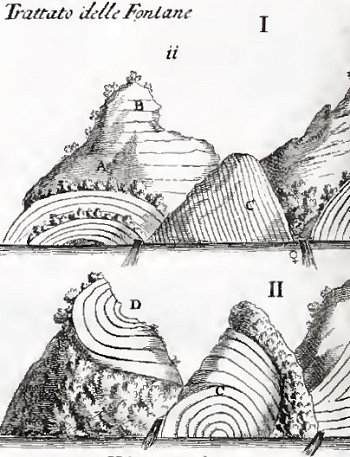 |
|
|
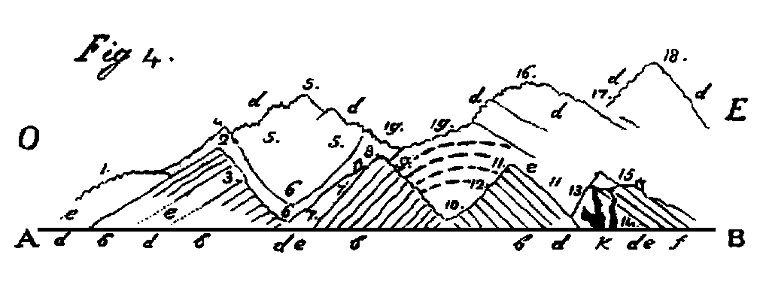
Paolo Savi
(1833): "cut" of the Apuan Alps (cross-section for a first
'plutonist' interpretation of the apuan elipsoid)
|
|
|
In 1833, for the first time the Apuan Alps are shown in a geological
cross-section in a work by Paolo Savi (1798-1871) who gives a ‘Plutonic’
interpretation of the mountain range. According to him, it was raised by the
intrusion of a deep magma body and became a remnant of an ancient orographic
ridge – called “metalliferous chain” – originally situated in the area from
La Spezia to Mt. Argentario.
For almost half a century, literature on geology was dominated by the
scientific contributions of Italian and foreign geologists (Coquand, Pareto,
Puggard, Simi, Cocchi, De Stefani) who used to support the well-established
theory of the Apuan Alps as a single anticline of Plutonic origin. Research
is, nevertheless, rich in surprises and important discoveries. In 1872,
Antonio Stoppani (1824-1891) and Igino Cocchi (1827-1913) in two different
studies found the first morainic deposits in the Apuan Alps and presented
them to the scientific community as the first Apennine marks of the
Quaternary Glaciations.
|
|
|
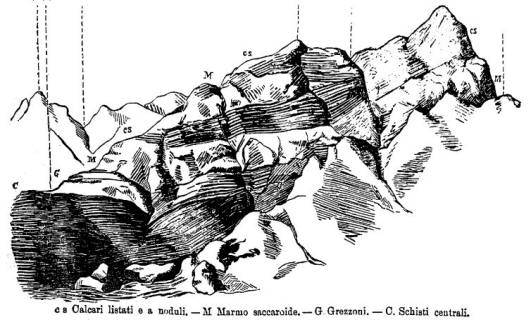 |
Modern geology began with a systematic survey of the Apuan Alps completed
between 1879 and 1890 by Bernardino Lotti (1847-1933) and Domenico Zaccagna
(1851-1940). The two engineers of the Geological Royal Committee belonged to
the ‘autochthonist’ school of thought assigning the Apuan rocks to a single
stratigraphic sequence excluding any possibility of nappe overlapping.
Therefore, they proposed a folding tectonics characterized by regular folds
with double vergence without dealing with the existence of faults.
Domenico
Zaccagna
(1881): Mt. Sagro natural section |
|
|
The map
drawing was completed by Domenico Zaccagna alone, who retrieved and developed the
contemporary studies by Igino Cocchi (1827-1913) and Carlo De Stefani
(1850-1924), in compliance with the geological survey project presented at
the Second International Congress in Bologna in 1881. These are the first
examples of modern geological cartography in Italy.
|
|
|
 |
The scientific commitment was matched with the institutional interest of the
Geological Committee, which aimed at providing the Apuan marble mining industry with an
useful instrument in a historic moment of remarkable spreading of quarrying
activities beyond the traditional basins of Carrara, Massa and the area of
Versilia.
In 1917, despite their sheer ‘autochthonist’ approach, the Zaccagna and
Lotti’s geological map enabled, Stanislaw Lencewicz (1889-1944) to
reinterpret the structure of the mountain range from an ‘allochthonist’
perspective, showing the tectonic duplication of the Tuscan sequence.
|
|
|
Domenico
Zaccagna
(1880-1886): Mt. Sagro's geological map - scale 1:25.000 |
|
|
|
For the very first time in
the history of the Apuan Alps and Apennines the allochthonous origin of nappes was recognized, though it had already been
proposed by Lugeon and Argand for the Pennine Alps (1905) on the basis of
the overthrusting of two equivalent stratigraphic sequences. In the
following two decades the geological studies, especially by experts from the
central European school and culture, enabled the identification of a
‘tectonic window’ in the central part of the Apuan range. In particular, in
1926, Norbert Tillman (1883-1947) described the Apuan Alps as a complex
structure of folded sedimentary sequences which are overturned, faulted and
tectonically overlapped. After the Second World War the main subject of
geological studies was the gravitational sliding of nappes, which led Carlo
Migliorini (1891-1953) to formulate the theory of ‘composite wedges’ (1948),
according to which nappes may gradually slip for hundreds of kilometres
through different and subsequent phases thanks to a limited number of
inclined surfaces. The interpretation was then retrieved and developed by
Giovanni Merla (1906-1983) and Livio Trevisan (1909-1996), who, shortly
afterwards, described a gravitational sliding of nappes progressively moving
from the Tyrrhenian to the Adriatic area thanks to the upthrust of
subsequent tectonic ‘ridges’ or ‘wrinkles’. In the same period, Felice
Ippolito (1915-1997) carried out geological-petrographic studies on the
Apuan Alps and Pisani Mountains assigning the Apuan rocks to three
superposed sequences. The ‘Autochthonous’ sequence is the deepest one and is
overthrusted by an equivalent lithological sequence, called ‘Tuscan Nappe’
which is in turn topped by the ‘Ligurian Unit’.
|
|
|
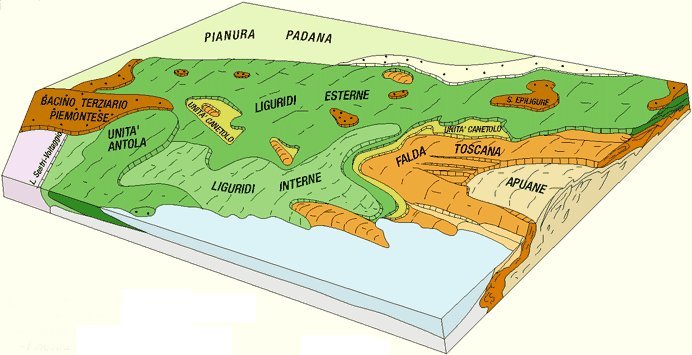
Piero Elter
(1974): Northern Apennines diagram block
|
|
|
In the 1960’s the Apuan Autochthon is described, especially by Enzo Giannini
(1919-1992), as the most remarkable part of a structural high (geoanticline)
which divides the two main basins, the ‘inland’ (eugeosyncline) and the
‘outer’ one (miogeosyncline). The Apuan tectonic ridge was allegedly
overthrusted by the Tuscan and Ligurian units because of tangential pushes
by the oceanic area towards the foreland, thus leading to the late formation
of rigid structures such as horsts (Apuan) and grabens (Serchio
Valley).
The quality leap in the interpretation of the evolution of the Apuan Alps
and Northern Apennines was made thanks to the theoretical support of ‘plate
tectonics’ or ‘global tectonics’ with the identification of the physical
“engine” able to provide the necessary push for large translations of nappes.
After 1975, a series of studies on the geometry of polyphase deformations,
created by the superposition of different tectonic phases, took place within
a framework consistent with the Cenozoic paleographic evolution and crustal
movements of the western Mediterranean area.
|
|
[link_eng.html] |
